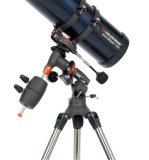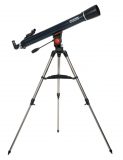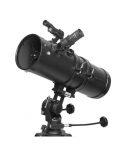
On a clear night when you look up at the sky, you can see an amazing spectacle of stars, constellations, and planets. With the naked eye, the degree of clarity and detail of what can be observed is limited. If you’re like me and want to see these objects in greater detail, a good telescope is needed. Telescopes are the primary tool that astronomers use when observing the night sky. Like all tools, telescopes come in many shapes and sizes and are built for a specific purpose. Today we’re going to discuss five tips that will help you purchase your first telescope.
1. Choose a telescope for your purposes and interests
 The first step in your journey to buying a telescope is knowing what your observing interests and needs are. Take a moment to think about what you’d like to observe. Are you interested in near earth objects like the moon, deep sky objects like galaxies, or perhaps something a little closer to home, such as bird watching? Knowing the answer to these questions will help you narrow down your list of telescopes and personal preferences. For example, if you’re interested in viewing deep sky objects, telescopes made for this purpose can be larger, heavier, and more difficult to transport.
The first step in your journey to buying a telescope is knowing what your observing interests and needs are. Take a moment to think about what you’d like to observe. Are you interested in near earth objects like the moon, deep sky objects like galaxies, or perhaps something a little closer to home, such as bird watching? Knowing the answer to these questions will help you narrow down your list of telescopes and personal preferences. For example, if you’re interested in viewing deep sky objects, telescopes made for this purpose can be larger, heavier, and more difficult to transport.
2. Telescope aperture and portability
Now that you know what you would like to observe, the next step is understanding what your aperture and portability needs are. Aperture is one of the most important aspects of a telescope. Aperture is the diameter of the primary lens or mirror in a telescope. It directly relates to the magnification power, light gathering potential, size, weight, and cost. Aperture plays a key role in gathering light and seeing the detail in objects. A telescope with a larger aperture has the potential to gather more light. This is important because the farther away an object is, the more light is needed to clearly see it. It is also noteworthy that aperture is also related to the size and weight of the telescope. Telescopes with large apertures have bigger lenses and mirrors, making them more difficult to transport.
3. Telescope mount
 Before diving into mounts, let’s clarify the difference between the telescope base and mount. A telescope base is typically a tripod, while the mount is what supports the movement of the telescope. Why is the mount of your telescope important? Mounts are directly related to how you will track objects across the sky. There are two types of mounts: Alt-Azimuth (AZ) and Equatorial (EQ).
Before diving into mounts, let’s clarify the difference between the telescope base and mount. A telescope base is typically a tripod, while the mount is what supports the movement of the telescope. Why is the mount of your telescope important? Mounts are directly related to how you will track objects across the sky. There are two types of mounts: Alt-Azimuth (AZ) and Equatorial (EQ).
AZ mounts have two axes of motion: up, down (y axis) and left, right (x axis). This type of mount is simple to set up and great for beginners. However, if you’re doing astrophotography or trying to track objects as they move across the sky, AZ mounts will require constant adjustment. Why? Stars in the night sky are not static. In fact, from our perspective on Earth, stars appear to move in a circular motion, rising in the east and setting in the west. The point that stars circle around is known as the celestial pole. Using an AZ mount to track a star across the night sky would require constant adjustments to both the x and y axis.
On the other hand, EQ mounts are made specifically to simplify the work needed to track stars. In addition to using the same axis as the AZ mounts, EQ mounts have two additional axes known as RA and Dec. During setup, the Dec axis is used to align your telescope to the celestial pole. Once this is done, tracking stars across the sky is as simple as adjusting the RA axis.
4. Telescope maintenance and image clarity
Another factor to consider in your purchase of a telescope is maintenance and image clarity. There are two primary types of telescopes that use different methods and materials to achieve similar results. These telescopes are refractor and reflector. I will briefly discuss the advantages and disadvantages of both.
Refractor Telescopes
 Refractor telescopes are often what people imagine when they think of telescopes. These telescopes use specialized glass to collect and focus light within a closed body system. The advantage of the closed body system is that there is almost no maintenance required. For example, owners do not need to worry about dust getting into the telescope, or aligning the lenses. Another advantage of refractor telescopes is that the specialized lenses produce clearer, sharper images with better contrast.
Refractor telescopes are often what people imagine when they think of telescopes. These telescopes use specialized glass to collect and focus light within a closed body system. The advantage of the closed body system is that there is almost no maintenance required. For example, owners do not need to worry about dust getting into the telescope, or aligning the lenses. Another advantage of refractor telescopes is that the specialized lenses produce clearer, sharper images with better contrast.
While the specialized lenses are one of the greatest strengths of refractor telescopes, they can also create disadvantages. Under certain apertures, refractor lenses can produce images with chromatic aberration. Chromatic aberration occurs when the lens system is unable to focus all the incoming light onto a single point. This results in a blue or purple halo around objects viewed. To counteract chromatic aberration, certain telescopes come with another specialized lens known as an apochromat. This lens helps to focus the extra light and therefore reduces the effects of chromatic aberration. The disadvantage of including apochromatic lenses in telescopes is that the overall cost of a telescope increases.
Reflector Telescopes
 Reflector telescopes gain their name from the mirror that is used to reflect light into the observer’s eyepiece. Instead of using a lens, reflector telescopes use a curved mirror to gather incoming light. The advantage of mirrors is that they are not susceptible to chromatic aberration. Regardless of the aperture size, you will not see blue or purple halos around objects viewed. Another advantage of using mirrors is the lower cost of manufacturing. The inclusion of mirrors and lack of chromatic aberration means that larger telescopes with more light-gathering potential can be made for a lower cost. An example of a large aperture reflector telescope is the Celestron 31045 AstroMaster. It has a 130mm aperture, giving you the potential to observe the cloud belts of Jupiter.
Reflector telescopes gain their name from the mirror that is used to reflect light into the observer’s eyepiece. Instead of using a lens, reflector telescopes use a curved mirror to gather incoming light. The advantage of mirrors is that they are not susceptible to chromatic aberration. Regardless of the aperture size, you will not see blue or purple halos around objects viewed. Another advantage of using mirrors is the lower cost of manufacturing. The inclusion of mirrors and lack of chromatic aberration means that larger telescopes with more light-gathering potential can be made for a lower cost. An example of a large aperture reflector telescope is the Celestron 31045 AstroMaster. It has a 130mm aperture, giving you the potential to observe the cloud belts of Jupiter.
As in the case of refractor telescopes, mirrors are a strength of reflector telescopes, but they also come with disadvantages. Mirrors will periodically need to be realigned and cleaned. If you transport your reflector telescope, the mirrors need time to adjust to the ambient temperatures before they can produce clear images. Finally, images produced by the mirrors of reflector telescopes are not as clear and do not have as much contrast as refractor telescopes.
5. Know your budget
By now you should have a good understanding of your observational needs, as well as the type of telescope and mount required to meet those needs. The last tip we have for you is knowing your budget. If you add all the bells and whistles, the price of telescopes can go up quickly. While budget is a big factor in your purchasing decision, I encourage you to strongly consider your observational needs. It may be worthwhile to spend a little bit more on a telescope that will satisfy your needs and leave room for growth.
Now that you’ve heard from me, I’d love to hear from you. What are you hoping to see the next time you look through your telescope? Let me know in the comments section below.
Shop telescopes and more online at Bestbuy.ca



